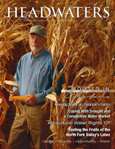By Tom Trout, USDA-ARS-Water Management Research

Tom Trout checking out the CoAgMet weather station instrumentation. Credit: Peggy Greb
Water rights transfers in Colorado are based on consumptive use. A city or company that purchases water from a farmer can only use the amount of water that the farmer has historically consumed—that is, the water that actually evaporated and transpired from the crop and soil. Thus, they must estimate the evapotranspiration, or ET, for the fields that had been irrigated. The method to estimate ET commonly used in Colorado is an old method developed over 50 years ago called the Blaney-Criddle method. The method is based only on temperature and is simple, but not very accurate.
Much more accurate ET calculation methods are now available. ET weather station networks in Colorado—Colorado Agricultural Meteorological Network (CoAgMet), and Northern Water’s network—have been collecting detailed weather data for over 20 years that can be used to calculate reference ET using globally-recognized standardized methods. Satellites have been collecting images of farm crops for over 30 years. These technologies can be combined to improve ET estimates over the past month or season or several years.
Learn about these newer technologies and the advantages and disadvantages compared to current methods at the Third Colorado ET Workshop. The workshop will present ET estimation methods and the information required to use them, including weather and satellite data. Presenters will also describe the latest research in ET estimation for both well-irrigated and deficit-irrigated crops. They will discuss how these methods could be used for more accurate and standardized consumptive use calculations for both permanent water transfers and alternative temporary transfers.
The Third Colorado ET Workshop will be held in Fort Collins on October 13, 2016. Workshop organizers include USDA-Agricultural Research Service, Colorado State University, Colorado Division of Water Resources, and Colorado Water Conservation Board.


![]()
![]()
The workshop is part of the Ninth International Conference on Irrigation and Drainage organized by the U.S. Committee on Irrigation and Drainage (USCID) taking place October 11-14 at the Fort Collins Hilton. The theme of the USCID conference is:
| Improving Irrigation Water Management—Latest Methods in Evapotranspiration and Supporting Technologies |
The conference will include many presentations on the latest ET research. The recently published ASCE Manual “Evaporation, Evapotranspiration, and Irrigation Water Requirements” will be introduced at the conference. Participants can register for the whole conference, or just the Thursday Colorado ET Workshop. Learn more and register here.
Read more about Tom Trout’s  recent work in “The Ever Evolving Farmer” in the Fall 2012 issue of Headwaters magazine.
recent work in “The Ever Evolving Farmer” in the Fall 2012 issue of Headwaters magazine.

 Print
Print
Reblogged this on Coyote Gulch.